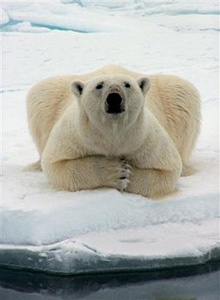 |
 |
 |
 Editorials | Environmental | September 2007 Editorials | Environmental | September 2007  
Polar Bear Population Seen Declining
 Associated Press Associated Press
go to original


| | Two-thirds of the world's polar bears will be killed off by 2050 because of thinning sea ice from global warming in the Arctic. |
Two-thirds of the world's polar bears will be killed off by 2050 - and the entire population gone from Alaska - because of thinning sea ice from global warming in the Arctic, government scientists forecast Friday.

Only in the northern Canadian Arctic islands and the west coast of Greenland are any of the world's 16,000 polar bears expected to survive through the end of the century, said the U.S. Geological Survey, which is the scientific arm of the Interior Department.

USGS projects that polar bears during the next half-century will disappear along the north coasts of Alaska and Russia and lose 42 percent of the Arctic range they need to live in during summer in the Polar Basin when they hunt and breed. A polar bear's life usually lasts about 30 years.

"Projected changes in future sea ice conditions, if realized, will result in loss of approximately two-thirds of the world's current polar bear population by the mid 21st century," the report says.

Polar bears depend on sea ice as a platform for hunting seals, which is their primary food. They rarely catch seals on land or in open water. Because the general decline of Arctic sea ice appears to be underestimated, scientists said their forecast of how much polar bear populations will shrink also may be on the low side.

"There is a definite link between changes in the sea ice and the welfare of polar bears," said USGS scientist Steven Amstrup, the lead author of the new studies. "As the sea ice goes, so goes the polar bear."

Amstrup said 84 percent of the scientific variables affecting the polar bear's fate was tied to changes in sea ice.

As of this week, the extent of Arctic sea ice had fallen to 4.75 million square miles - or 250,000 square miles below the previous record low of 5.05 million square miles in September 2005, according to the National Snow and Ice Data Center.

Scientists do not hold out much hope that the buildup of carbon dioxide and other industrial gases blamed for heating the atmosphere like a greenhouse can be turned around in time to help the polar bears anytime soon.

Polar bears have walked the planet for at least 40,000 years.

"In spite of any mitigation of greenhouse gases, we are going to see the same amount of energy in the system for at least 20, 30, 40 years," Mark Myers, the USGS director, said.

Greenland and Norway have the most polar bears, while a quarter of them live mainly in Alaska and travel to Canada and Russia. The agency says their range will shrink to no longer include Alaska and other southern regions.

The findings of U.S. and Canadian scientists are based on six months of new studies, during which the health of three polar bear groups and their dependency on Arctic sea ice were examined using "new and traditional models," Myers said.

USGS issued nine separate reports on polar bears Friday. Those included projections for one group of polar bears in the Southern Beaufort Sea and two in Canada that are among 19 distinct subpopulations.

They were made public to help guide Interior Secretary Dirk Kempthorne's decision expected in January on his agency's proposal to add the polar bear to the government's endangered species list.

USGS declined to provide precise estimates of polar bear populations 50 years from now.

A separate organization, the World Conservation Union, based in Gland, Switzerland, has estimated the polar bear population in the Arctic now is about 20,000 to 25,000, put at risk by melting sea ice, pollution, hunting, development and tourism.

Last December, Kempthorne proposed designating polar bears as a "threatened" species deserving of federal protection under the Endangered Species Act, because of melting Arctic sea ice from global warming. That category is second to "endangered" on the government's list of species believed most likely to become extinct.

That action is in response to a lawsuit in 2005 by three environmental groups - the Center for Biological Diversity, Natural Resources Defense Council and Greenpeace - to force such a proposal from Interior's Fish and Wildlife Service, which oversees endangered species.

"This grim news about polar bears and sea ice decline is horrifying, but it is a call to action, not despair," said Kassie Siegel of the Arizona-based Center for Biological Diversity. "The good news is that there is still time to save polar bears. Our hope lies in a rapid response, including both deep and immediate carbon dioxide reductions and a full-court press on other greenhouse pollutants such as methane."

The fate of polar bears has struck a public nerve. Fish and Wildlife officials have received 600,000 public comments so far on the proposed listing, spokesman Chris Tollefson said.

On Friday, Rep. Edward Markey, D-Mass., urged the Bush administration to grant polar bears federal protection.

"This is becoming a tragic metaphor for the administration's voluntary approach to global warming," said Markey, chairman of the House Select Committee on Energy Independence and Global Warming. "Instead of meeting the challenge, the Bush administration is happy to float along, waiting to see if the planet, and polar bears, will sink or swim."

Another member of the committee, Rep. Jay Inslee, D-Wash., said the loss of some of the magnificent creatures on earth may be the proverbial "canary in the coal mine" needed to prod both Congress and the Bush administration into action on climate change.

On the Net: USGS.gov | 
 | |
 |



